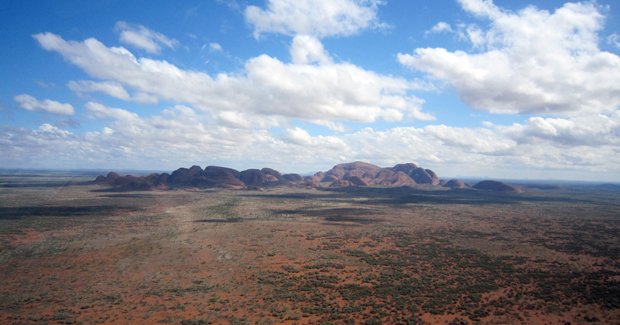The greening of the Red Centre

YOU HAVE CERTAIN PICTURES in your mind when you think of Central Australia’s Uluru-Kata Tjuta National Park. Mostly the visual include the Rock set in a wide plain of dusty red dirt, brittle yellow-looking spinifex and spindly desert oaks – all contrasted against a bright blue cloudless sky.
I’ve been taken aback – and thrilled – to find something quite different here on my first visit to Australia’s spectacular Red Centre. Lush, green vistas are the order of the day and brooding layers of cloud are more common than clear skies. One night, after I watched the sun set over Uluru from the top of a sand dune, I stayed out there a little longer to follow distant lightning storms dancing along the horizon.
Kata Tjuta has what appears to be great green stripes of lichen or algae flourishing on the sides of some of its red domes; wildflowers of numerous types are all around the basewalk of Uluru and adorn the sunset and sunrise viewing areas; meandering streams, puddles of water, lush foliage and many more flowers are found decorating Kata Tjuta’s Walpa Gorge.

Trickles of water run through Kata Tjuta’s Walpa Gorge (Photo: John Pickrell).
Heavy rain causes almost instant waterfalls to come thundering off Uluru in fine streams. “Uluru has many moods. In the rain it can have a silvery sheen as sheets of water cascade down the sheer sides,” writes Anne Kerle, author of one of the definitive books about the region. “After rain, the Rock becomes steely grey under a threatening sky. These colours can be just as impressive as the rich reds.”
It’s rare that you get to experience the wide variety of flora and fauna out here in the typical two-to-three-day flying visit, but with the drenching rains that continued throughout most of 2010 everything is in bloom at the moment, making it a great time to visit.
“There’s been so much rain this year, I’ve been telling people that we risk having our desert status challenged,” says Martha Coomber of Uluru-Kata Tjuta National Park. “The difference water makes is phenomenal – you can see everything around you coming to life in a frantic rush to sow seeds or breed, to make the most of the water while it’s available.”
Martha tells me that the park has had to organise emergency training in plant identification for staff, because they are finding plants that none of them have seen before. “It’s so exciting to witness everything bursting into life. The process is very intense – the flowers brief and spectacular – the seedpods overwhelming in numbers, the flurry of life being born all around you. It’s wonderful. I am so glad I am here to see it,” she says.
I’ve spotted too many different wildflowers to recount during my trip, but a smattering of them include: the bell-shaped blooms of the spearbush; small yellow balls on the spiky (and weirdly named) dead finish; the delicate pink flowers of the lilly ‘early nancy’; the bright pink blooms of the succulent, parakeelya; the nectar filled honey grevillea and holly grevillea; tiny bluebells; cattle bush; yellowtop; bush tomatoes; deep red Sturt’s desert peas; and the bottle-brush-shaped, mauve ‘tall mulla mulla’.
On my third day out in the Red Centre we get up very early one morning to make the three-hour drive from Uluru’s Yulara resort to Watarrka National Park (home to Kings Canyon), around 100 km to the northeast. We spend much of the drive passing through the vast Curtin Springs (416,000 ha) and Kings Creek (180,000 ha) cattle stations.
As the sun rises and I start to get a better look at the surroundings I realise that it isn’t how I’d pictured this part of Australia at all. Everything is covered in fresh new growth – if anything the intense green is more reminiscent of the English countryside in spring.
At one point we have to pull to a sudden halt at seven camels – a mixture of adults and juveniles – canter across the road, their humps wobbling from side to side. They pull up on one side of the vehicle and peer at us, before being swallowed up once more by the thick green shrubbery.

Kata Tjuta captured from a helicopter flight over the National Park (Photo: John Pickrell)
Australian Geographic thanks Voyages Ayers Rock Resort, Tourism NT, Anangu Tours and Uluru Express for helping facilitate this visit.




